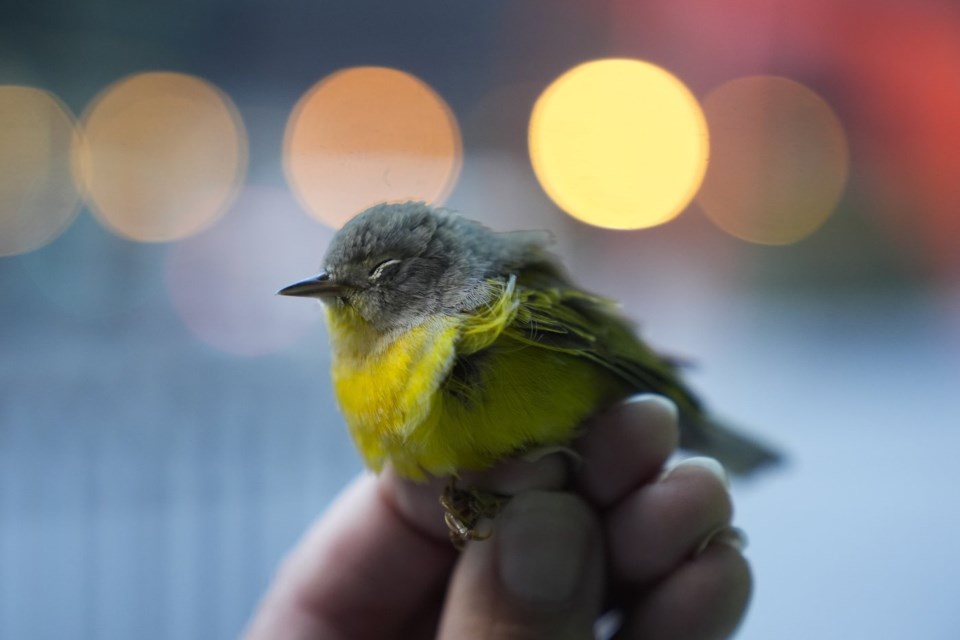CHICAGO (AP) — With a neon-green net in hand, Annette Prince briskly walks a downtown Chicago plaza at dawn, looking left and right as she goes.
It’s not long before she spots a tiny yellow bird sitting on the concrete. It doesn't fly away, and she quickly nets the bird, gently places it inside a paper bag and labels the bag with the date, time and place.
“This is a Nashville warbler," said Prince, director of the Chicago Bird Collision Monitors, noting that the bird must have flown into a glass window pane of an adjacent building. “He must only weigh about two pennies. He’s squinting his eyes because his head hurts.”
For rescue groups like the Chicago Bird Collision Monitors, this scene plays out hundreds of times each spring and fall after migrating birds fly into homes, small buildings and sometimes Chicago's skyscrapers and other hulking buildings.
A stark sign of the risks came last fall, when 1,000 migrating birds died on a single night after flying into the glass exterior of the city's lakefront convention center, McCormick Place. This fall, the facility unveiled new bird-safe window film on one of its glass buildings along the Lake Michigan shore.
The $1.2 million project installed tiny dots on the exterior of the Lakeside Center building, adorning enough glass to cover two football fields.
Doug Stotz, senior conservation ecologist at the nearby Field Museum, hopes the project will be a success. He estimated that just 20 birds have died after flying into the convention's center's glass exterior so far this fall, a hopeful sign.
“We don’t have a lot of data since this just started this fall, but at this point, it looks like it’s made a huge difference," Stotz said.
But for the birds that collide with Chicago buildings, there is a network of people waiting to help. They also are aiming to educate officials and find solutions to improve building design, lighting and other factors in the massive number of bird collision deaths in Chicago and worldwide.
Prince said she and other volunteers walk the streets downtown to document what they can of the birds that are killed and injured.
“We have the combination of the millions of birds that pass through this area because it’s a major migratory path through the United States, on top of the amount of artificial lighting that we put out at night, which is when these birds are traveling and getting confused and attracted to the amount of glass,” Prince said.
Dead birds are often saved for scientific use, including by Chicago's Field Museum of Natural History. Rescued birds are taken to local wildlife rehabilitation centers to recover, such as the DuPage Wildlife Conservation Center in suburban Illinois.
On a recent morning, veterinarian Darcy Stephenson at DuPage gave a yellow-bellied sapsucker anesthetic gas before taping its wings open for an X-ray. The bird arrived with a note from a rescue group: “Window collision.”
Examining the results, she found the bird had a broken ulna — a bone in the wing.
The center takes in about 10,000 species of animals annually and 65% of them are avian. Many are victims of window collisions and during peak migration in the fall, several hundred birds can show up in one day.
“The large chunk of these birds do actually survive and make it back into the wild once we’re able to treat them,” said Sarah Reich, head veterinarian at DuPage. “Fractures heal very, very quickly in these guys for shoulder fractures. Soft tissue trauma generally heals pretty well. The challenging cases are going to be the ones where the trauma isn’t as apparent.”
Injured birds go through a process of flight testing, then get a full physical exam by the veterinary staff and are rehabilitated before being set free.
“It’s exciting to be able to get these guys back out into the wild, especially some of those cases that we’re kind of cautiously optimistic about or maybe have an injury that we’ve never treated successfully before," Reich said, adding that these are the cases "clinic staff get really, really excited about.”
Erin Hooley And Teresa Crawford, The Associated Press



